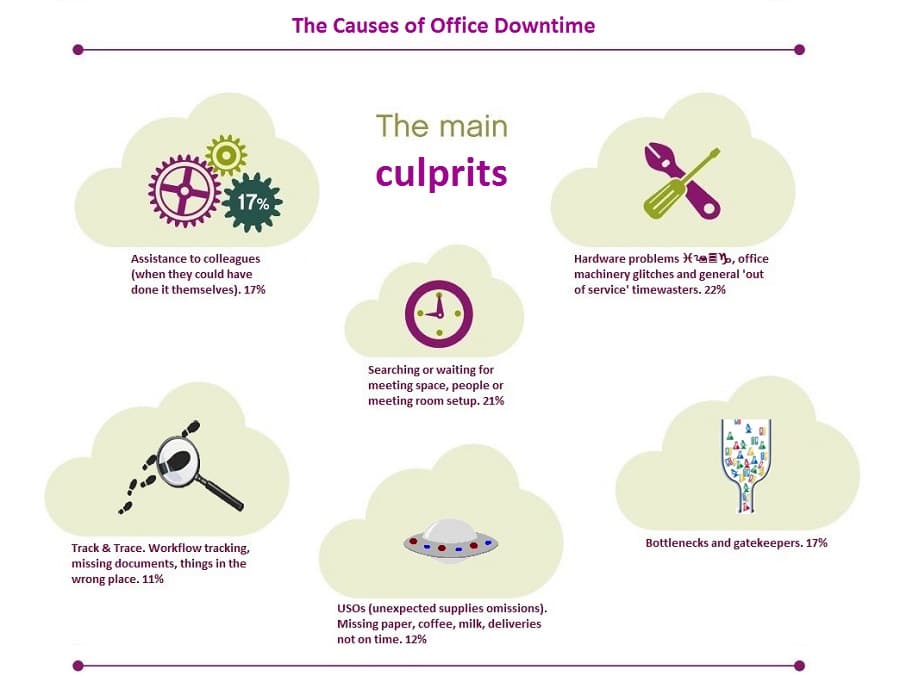
A light-hearted survey of Fusion clients and friendly office dwellers has shown several common causes of downtime in the office. Sparked by a conversation about being busy and how the office can fall short as a productive place to be, Fusion looked at some of the culprits for office downtime.

In first place by a narrow margin the award goes to labour-saving hardware in all its forms, from printers and computers, software and AV kit through to coffee machines, delinquent copiers and baffling binding machines. No doubt there is an honourable mention for franking machines too.
Narrowly pipped at the line was time wasted looking for a meeting space when you haven’t booked, waiting for everyone to convene or just spent setting up a meeting room. No wonder those clever lawyers have meeting suite ‘hosts’ to attend to rooms between meetings, sorting out biscuits and drinks, tables and chairs. Not sure they can hunt down the person who decides to visit the loo on route to a meeting, though.
In equal 3rd place are people and processes, or bottlenecks, gatekeepers and assistance. Bottlenecks come in many forms, and good offices will have them designed out initially, but they have a habit of creeping back in. Mobile phones and the social web may have a part to play here. Gatekeepers will have power. Sometimes just enough to slow down proceedings, occasionally more than enough. Gatekeeping isn’t always a negative. Good gatekeeping can be helpful screening unwanted calls or interruptions.
Colleague assistance for those tasks when they could really do it themselves can be a distraction. Starting with best intentions to help someone keep their day on track can end up with a black hole of input only to find out that they probabaly knew what to do in the first place.
In 5th place are USOs or unexpected supplies omissions. A printer cartridge out of stock, down to the last teabag, or just waiting longer for a delivery than you’d been led to believe are all examples of USOs. USOs also include a few mysteries. What happened to the promotional mugs in a cupboard, how did we run out of dishwasher tablets when there was a new pack two days ago. Where did the ‘good’ biscuits for client meetings go?
In last place is the ‘track and trace’ event beloved by all office Ms Marples and budding Hercule Poirots. In the ’80s this would have been called filing problems but has expanded as electronic systems overlap, people with knowledge go AWOL and plain old mislaid documents still drag proceedings down. One survey respondent did mention missing glasses and we’ve included this in the track and trace phenomenon.
5 out of the 6 main culprits for downtime can be ascribed to that broad catch-all ‘human nature’ and there’s no denying we all play a role in the odd bit of unproductive office time.
Architects HOK conducted research into workplace trends with an interesting view on office productivity.
‘Buildings can improve overall productivity and performance by as much as 12.5 percent or reduce them by as much as 17 percent. That’s a 30 percent swing between employee performance in the best and worst buildings.
Interestingly, the same factors that enable productivity can inhibit it. Some background noise, for example, can boost productivity for routine or administrative tasks. Yet that same noise can be highly distracting when employees are conducting research or writing tasks. Lighting is generally viewed as positive, except when it causes glare. That said, the most common building-related culprits for hindering productivity include issues with thermal comfort or air quality, lack of natural light, noise, spaces that feel crowded and poor ergonomics.’
Combating office downtime is a process of small improvements across a diverse range of causes with no silver bullet but instead needs attention to design, base build aspects and consideration from and for others.
View our office design page.